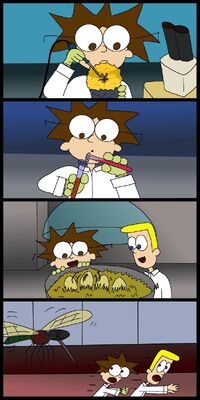

- "Once the computer has analyzed the DNA, how do you know what animal it encodes?"
- —Dr. Alan Grant(src)
After the fossil DNA has been sequenced, it is possible to determine from what animal the DNA originated. Identifying the species of the extracted DNA is needed to identify contamination by extant species. Furthermore, the species has to be known to correctly fill the sequence gaps and to perform successful cloning.
In the novel Jurassic Park Henry Wu isn't that concerned about knowing the species of the extracted DNA. "Just grow it and find out what it is."[1]
Jurassic Park media[]
In most Jurassic Park media dinosaur DNA is obtained from mosquitoes in amber that might had fed on dinosaurs. This makes it hard to determine the species the DNA belonged to. When Henry Wu is confronted with this by Alan Grant he responds that, there are two methods to identify the species.
"DNA evolves over time, like everything else in an organism... We can take an unknown piece of DNA and determine roughly, by computer, where it fits in the evolutionary sequence. It's time consuming, but it can be done."[1]
However, most of the time, they "just grow it and find out what it is."[1]
When he shows the endorsement team the hatchery, there are a batch of eggs that are labeled "XXXX-0001/1" and "Presumed Coelu". Wu explains:
"That's a new batch of DNA. We don't know exactly what will grow out. The first time an extraction is done, we don't know for sure what the animal is."[2]
Criticism[]

Dr. Wu: "Just grow it and find out what it is."
Many scholars have criticised the method used by Henry Wu. Dr. Sandy Becker called it sarcastically a "minor credibility gap."[3]
In a TED conferences Jack Horner ridiculed the entire Jurassic Park method of recreating dinosaurs because of this.
I assume everybody knows that if you actually had a piece of amber that had an insect in it, and you drilled into it and you got something out of that insect, and you cloned it, and you did it over and over again, you would have a room full of mosquitoes. Poor babies. And probably a whole bunch of trees as well.[4]
DeSalle and Lindley wrote in The Science Of Jurassic Park And The Lost World that even if you would find and extract blood cells from a bugs gut:
you couldn't be sure that blood inside an insect was dinosaur blood and not rodent blood.
Insects don't have blood[]
Compare with known sequences[]
In any sequencing project it is necessary to check the origin of each DNA fragment. Even if all DNA fragments are endogenous, it could be that all fragments are from Mitochondria or (in plants) Chloroplasts. BLAST is an often used tool. BLAST compares any DNA sequence with all known sequences. Even if the sequence is of an unknown species, BLAST can still determine whether the sequence is mammalian or bacterial etc.
In 2013 the genome was sequenced of a 700,000 years old horse was sequenced. They sequenced 12 billion extracted DNA molecules. When they used sequence comparing tools like BLAST they discovered that only 40 million (1 in 300) were of horse origin.[5].
This shows it is possible to distinguish dino DNA from tree, insect or rodent DNA.
Compare with known dinosaur sequences[]
The previous method can tell us if the DNA was from a dinosaur. However, that isn't specific enough. Not all dinosaur species had the same DNA. For example, Theropod genomes (DNA per cell) were half the size of Ornithischian dinosaurs. Therefore, the species of the DNA sample has to be known before the gaps can be filled.
The genus can be identified by comparing the DNA with the code of proteins collected from dinosaur bones (see Proteins in fossils). The species of bones can (often) be identified by paleontologists. Therefore, the species of the proteins is also known.
This is an example.
Imagine that DNA was discovered in amber. Bioinformaticians could use software to find the Collagen, type I, alpha 1 gene in the amber DNA.
A piece of the gene could read like this:
If you would translate this sequence into amino acid (protein) code, it would read
This amino acid code is identical to the Collagen code of Tyrannosaurus rex. So, we could conclude that the DNA belongs to Tyrannosaurus or a close relative.
If the DNA would read like this:
The amino acid code would be
This code corresponds with the Collagen of Brachylophosaurus, a close relative of Hadrosaurus.
As for 2014, only a few dinosaur proteins were sequenced. However, there is no reason that it will stay this way for the comming years.
References[]
- ↑ 1.0 1.1 1.2 Jurassic Park (novel), page 107.
- ↑ Jurassic Park (novel), page 109.
- ↑ Sandy Becker (2008). The Science of Michael Crichton, page 75.
- ↑ Jack Horner, TED conference, 02:57-05:05. Link: Jack Horner: Building a dinosaur from a chicken.
- ↑ J.J. Lee (2013). World's Oldest Genome Sequenced From 700,000-Year-Old Horse DNA, National Geographic. Link
